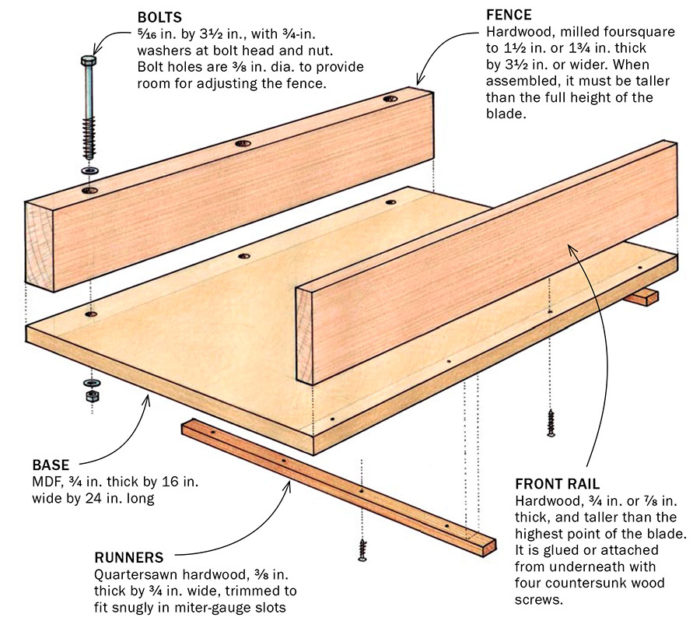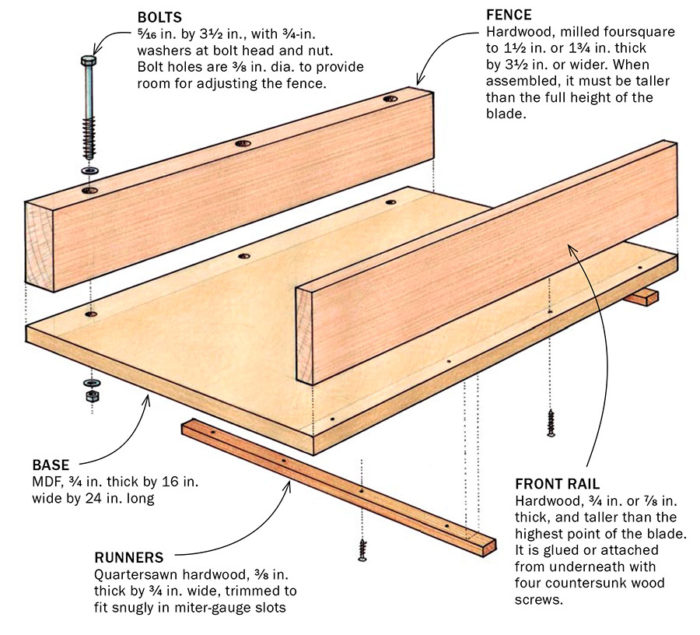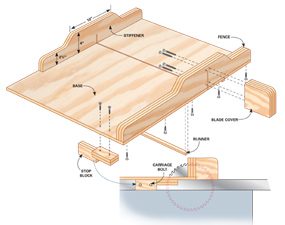Did you know that when it comes to table saw sleds, size matters? A table saw sled is a valuable tool for making accurate and safe cuts on a table saw. But how do you determine the right size for your sled? Let’s dive into the world of table saw sled dimensions and find out what size should a table saw sled be!
When it comes to the size of a table saw sled, there are a few factors to consider. One important consideration is the size of your table saw’s surface. You’ll want a sled that fits securely and doesn’t hang off the edges. Additionally, the size of the projects you typically work on should influence the size of your sled. A smaller sled may be suitable for small projects, while a larger sled will provide more stability for bigger pieces.
Another factor to think about is the size of your workspace. If you have limited space in your workshop, a compact sled would be a better fit. On the other hand, if you have a spacious work area, you can opt for a larger sled that offers more versatility. Ultimately, the size of your table saw sled should be a balance between your workspace, your projects, and the table saw itself.
Now that you understand the importance of choosing the right size for your table saw sled, let’s explore some guidelines and tips to help you make an informed decision. So, grab your measuring tape and get ready to build the perfect sled for your table saw!

What Size Should a Table Saw Sled Be?
A table saw sled is an essential tool for woodworking enthusiasts. It allows for precise and safe crosscutting, making it easier to achieve accurate and consistent results. However, determining the right size for your table saw sled can be a bit tricky. In this article, we will explore the factors to consider when determining the size of your table saw sled to ensure optimal performance and usability.
Factors to Consider
When deciding on the size of your table saw sled, several factors come into play. The first factor to consider is the size of your table saw’s surface. The sled should fit comfortably on the table saw’s surface without any interference from the blade or any other machinery components. Measure the dimensions of your table saw’s surface, taking into account any extensions or additions you may have added.
The next factor to consider is the size of the workpieces you typically handle. If you mostly work with smaller pieces, a smaller sled will suffice. However, if you frequently work with larger materials, a larger sled will provide better support and stability. Additionally, consider the size of your workshop and the available space for maneuvering the sled. A larger sled may require more space, so make sure you have enough room to comfortably operate it.
Lastly, consider the type of cuts you will be making with the sled. If you primarily make crosscuts, a standard-sized sled will do the job. However, if you often make angled or beveled cuts, you may need a sled with adjustable or angled fences to accommodate those cuts. Keep these factors in mind when determining the size of your table saw sled to ensure it meets your specific needs.
Determining the Size
Now that you have considered the various factors, it’s time to determine the ideal size for your table saw sled. To do this, start by establishing the maximum width and length of the sled based on your table saw’s surface dimensions. This will ensure that the sled fits perfectly on your table saw without any overhang or interference.
Next, consider the workpieces you handle most frequently. Measure the largest workpiece you typically work with and add a few inches to each dimension to ensure ample support and stability. This will give you the overall size of the sled’s base. Additionally, if you often work with longer pieces, consider adding extensions to the sled to provide additional support.
Finally, determine whether you need any special features or accessories on your sled, such as adjustable fences or stop blocks for angled cuts. Incorporate these features into the overall size and design of your sled. By considering all these factors and taking accurate measurements, you can determine the perfect size for your table saw sled.
Benefits of the Right Size Sled
Using a table saw sled that is the appropriate size offers several benefits. Firstly, it provides stability and support, allowing for precise and accurate cuts. A sled that is too small or too large may lead to wobbly and inconsistent cuts. With the right size sled, you can have confidence in the accuracy of your cuts and achieve professional results.
Secondly, a properly sized sled ensures safety during operation. A sled that matches the dimensions of your table saw’s surface reduces the risk of kickback and keeps your hands and fingers away from the blade. Additionally, a larger sled provides more room for maneuvering and better control over the workpiece, further improving safety and reducing the chances of accidents.
Lastly, a table saw sled that fits your specific needs and preferences enhances overall productivity and efficiency in your woodworking projects. It allows you to work smoothly and comfortably, reducing the time and effort required to complete tasks. By investing in a sled of the right size, you can optimize your workflow and enjoy a more enjoyable and efficient woodworking experience.
Tips for Using Your Table Saw Sled Effectively
Now that you have determined the ideal size for your table saw sled, let’s explore some tips to help you make the most of this valuable tool.
Ensure Proper Alignment
Before each use, make sure your table saw sled is properly aligned with the blade. Any misalignment can lead to inaccurate cuts and compromise your safety. Use a reliable square to ensure the sled’s fence is perpendicular to the blade and that the sled rides smoothly along the table saw’s surface.
Use Quality Materials
When building your table saw sled, opt for high-quality materials that can withstand the forces and pressure of woodworking. A sturdy and durable sled will provide better stability and longevity, ensuring optimal performance over time.
Consider Safety Enhancements
Enhance the safety of your table saw sled by incorporating features such as a blade guard, a hold-down clamp, or a featherboard. These additions can help prevent kickback and keep your hands protected during operation.
Regular Maintenance
Just like any other tool, your table saw sled requires regular maintenance to keep it in top condition. Clean the sled after each use, lubricate moving parts, and check for any signs of wear or damage. Performing routine maintenance will ensure the sled continues to function effectively and safely.
Common Mistakes to Avoid
While using a table saw sled can greatly enhance your woodworking experience, there are a few common mistakes to avoid to ensure optimal results and safety.
Using an Improperly Sized Sled
As discussed earlier, using a table saw sled that is either too small or too large can lead to instability and inaccurate cuts. Take the time to determine the ideal size for your sled based on your specific needs and table saw dimensions.
Neglecting Safety Precautions
Always prioritize safety when using a table saw sled. Wear appropriate protective gear, such as safety glasses and hearing protection. Familiarize yourself with the operating instructions of your table saw and sled, and follow all recommended safety precautions and guidelines.
Failure to Maintain and Clean the Sled
A dirty or poorly maintained sled can affect its performance and compromise your safety. Regularly clean and inspect your sled, removing any debris and lubricating moving parts as necessary. This will ensure smooth operation and extend the lifespan of your sled.
Wrap-Up:
Determining the right size for your table saw sled is crucial for achieving accurate and consistent cuts in your woodworking projects. Consider factors such as the size of your table saw, the workpieces you handle, and the types of cuts you make. By taking accurate measurements and incorporating any necessary features, you can build or purchase a sled that is perfectly suited to your needs.
Remember to prioritize safety and regular maintenance to ensure optimal performance and longevity of your table saw sled. With the right size sled and proper technique, you can enhance your woodworking skills and achieve impressive results with ease. Happy woodworking!
What Size Should a Table Saw Sled Be?
When determining the size of a table saw sled, there are a few key factors to consider. Here are the key takeaways for choosing the right size:
- A table saw sled should be wide enough to accommodate the width of your workpieces.
- It is important to ensure that the length of the sled allows for proper support and stability.
- Consider the size of your table saw and the available space in your workshop.
- Aim for a sled size that allows for easy movement and maneuverability on your table saw.
- Remember to take into account any additional features or attachments you might want to incorporate into your sled.
Frequently Asked Questions
Welcome to our FAQ section on choosing the right size for a table saw sled! Below, you’ll find answers to some common questions people have when selecting the dimensions of their table saw sled. Whether you’re a beginner or an experienced woodworker, we’ve got you covered.
1. How big should a table saw sled be?
When determining the size of your table saw sled, you’ll want to consider two key factors: the size of your table saw and the scope of your projects. As a general rule of thumb, the sled should extend beyond the blade by at least 6 inches on each side. This will provide ample support and stability for your workpieces. Additionally, the sled should be large enough to accommodate the size of the largest workpieces you plan on cutting.
However, it’s important to strike a balance between size and maneuverability. If the sled is too large, it may become cumbersome to handle. Take into account the available space in your workshop and your comfort level when working with larger sleds. Ultimately, the optimal size will depend on your specific needs and preferences.
2. What are the advantages of a larger table saw sled?
A larger table saw sled offers several advantages to woodworkers. First and foremost, it provides increased stability and support for larger workpieces. This prevents them from wobbling or shifting during the cutting process, resulting in more accurate and precise cuts.
Furthermore, a larger sled allows for greater versatility. You’ll have the freedom to make cuts on larger materials without worrying about their dimensions exceeding the sled’s capacity. This opens up possibilities for tackling more ambitious projects and gives you the confidence to work with a wider range of materials.
3. Are there any drawbacks to using a smaller table saw sled?
While smaller table saw sleds have their advantages, they do come with a few drawbacks to keep in mind. One of the main limitations is the reduced support they provide for larger workpieces. With a smaller sled, you may need to rely on additional cutting aids or techniques to ensure the stability of your materials. This can be time-consuming and may introduce some margin for error.
Additionally, a smaller sled may have a more limited capacity, restricting the size of the workpieces you can comfortably and accurately cut. This can be a hindrance when working on larger projects or when using thicker materials that require a wider support base. Evaluate your specific woodworking needs before deciding on the size of your sled to avoid potential drawbacks.
4. Can I customize the size of my table saw sled?
Absolutely! One of the great advantages of a table saw sled is its customizability. You can tailor the size of your sled to suit your specific projects, workspace, and cutting preferences. This allows you to maximize efficiency and comfort while working.
If you find that a commercially available sled doesn’t meet your requirements, you can easily build your own sled or modify an existing one. By doing so, you can precisely define the dimensions that work best for you, ensuring a seamless workflow and optimal results.
5. Are there any online resources or calculators to help determine the size of a table saw sled?
Yes, there are several online resources and calculators that can assist you in determining the ideal size for your table saw sled. These tools typically take into account the dimensions of your table saw, the width of your blade, and the space available in your workshop. They generate recommendations based on these factors, providing you with a starting point for sizing your sled.
While these resources can be helpful, it’s important to remember that they are just recommendations. Ultimately, the size of your sled should be based on your individual needs and preferences. Consider factors such as the types of projects you undertake, the size of your workpieces, and your comfort level when working with different sled sizes. Use these online resources as a guide, but trust your own judgment when making the final decision.
Summary
So, what size should a table saw sled be? The key is to make sure it is wide and long enough to support your workpieces securely. A good rule of thumb is to make the sled at least as wide as your table saw’s fence, and long enough to handle the length of your longest workpiece. This will ensure stability and accuracy in your cuts.
Additionally, it’s important to consider the materials you will be using and the type of cuts you will be making. If you’re working with large sheets of plywood, a bigger sled might be necessary. Finally, don’t forget to include safety features like anti-kickback devices and stop blocks to enhance your table saw sled’s functionality. With these considerations in mind, you’ll be ready to build a table saw sled that suits your needs perfectly. Happy woodworking!

